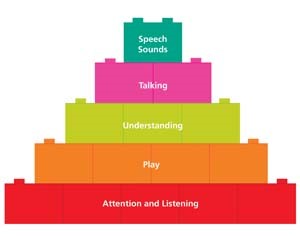Children can communicate with their communication partner by using a combination of sounds, gestures (e.g. pointing, waving “hello” and “bye”) and eye gaze (e.g. looking at you and then what he is ‘talking’ about). Your child may be sending a clear message – just not without words. Build your child’s language skills with some of these handy tips:
Put your child’s message into words
Place your child’s message into words of what you think he/she is trying to tell you. For example, if your child is pointing to their favourite blue cup wanting you to give it to him, say “You want the blue cup”. Keep it short to capture their message!!
Tell your child it’s their turn by pausing during a familiar routine
Encourage your child to “tell” you to continue a routine – allowing them to experience power of communication. Pause during an activity that you and your child are repeating over and over – such as tickles or jumping on a trampoline. For example, after you have jumped on the trampoline a few times, stop jumping and wait – without saying anything – to encourage your child to let you know that they want more jumping.
Use ‘fun’ words
Children enjoy sounds that are fun to ‘hear’ and ‘make’. These words are easy to remember and understand because they are said with lots of intonation. Examples of words include:
Boom! – when something falls
Yummy! Or Mmmm! – during meal times
Pop or uh-oh – during play with bubbles
Bye-bye – when you wave
Cheep-cheep, woof, oink-oink – sounds that animals make
Whee or crash – when playing with cars or trucks
Offer choices
Hold up two objects and ask “Do you want banana or some apple” showing each object in your hand as you say its name. Your child will use their own way to send you a message and let you know what she wants, including looking at the item they want, reaching, pointing or making a sound while looking at it. As soon as they let you know what they want, give it to her.
Be face to face
When playing with your child, get down at their physical level – so that the two of you are eye to eye. For example, sit facing your child when they are in a high chair, lie down on the floor when she is playing on the floor. When you are face to face, you and your child:
- connect more easily and share the moment
- see and hear each other’s messages better
Ask fewer questions
It can be difficult for your child to answer most questions when they are not yet using words. Try to reduce questions, balancing them with comments (or statements). Use your child’s interest to comment about things in everyday life. For example, comment on what your child’s doing “oh, you are squeezing the play dough” as your child squeezes some play dough. While your child is looking at animal pictures in a book, you could comment “That’s a small mouse”.
Written by Didem Karademir, Speech Pathologist.




















